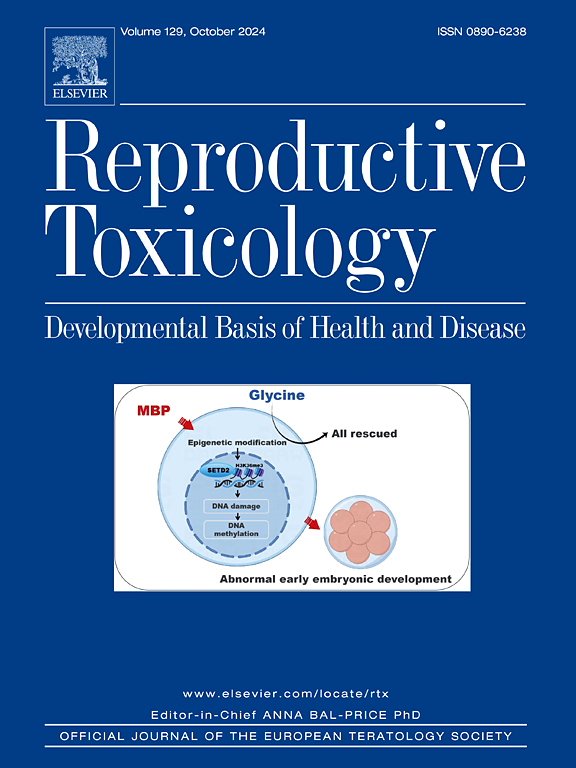Fucoxanthin mitigates mercury-induced mitochondrial toxicity in the human ovarian granulosa cell line
IF 3.3
4区 医学
Q2 REPRODUCTIVE BIOLOGY
引用次数: 0
Abstract
Mercury (Hg) is known to be a hazardous toxin with a significant negative impact on female reproduction through mechanisms that remain unclear. The carotenoid fucoxanthin (FX) is an antioxidant with several positive effects on human health. This study aimed to examine the potential protective role of FX in reducing the Hg-induced bioenergetic disturbances in a human ovarian granulosa cell line model. (methods briefly) Hg was found to reduce the viability of granulosa cells in a concentration-dependent manner, with an estimated 72-hour EC50 of 10 µM. In contrast, FX (10 and 20 µM) improved cell viability. Hg (1 and 10 µM) significantly reduced cellular ATP levels, mitochondrial membrane potential, oxygen consumption rates, and lactate production. Additionally, Hg impaired the activities and kinetics of mitochondrial complexes I and III and reduced the expression of mitochondrial genes ND1, ND5, cytochrome B, cytochrome C oxidase, and ATP synthase subunits 6 and 8. According to tests on mitochondrial membranes, Hg increased membrane fluidity by reducing saturated fatty acid levels and increasing those of unsaturated fatty acids. Hg also promoted mitochondrial swelling and enhanced the inner mitochondrial membrane permeability to hydrogen and potassium ions. FX (10 µM) was shown to mitigate the negative effects of Hg on the viability of treated granulosa cells, bioenergetics parameters, and mitochondrial membrane integrity in a concentration-dependent manner. Based on these findings, bioenergetic disruption may be a key underlying cause of Hg-induced ovarian dysfunction. Furthermore, FX may have a potential therapeutic role in treating ovarian disorders caused by Hg-induced disruption of granulosa cell bioenergetics.
岩藻黄素减轻汞诱导的人卵巢颗粒细胞系线粒体毒性
众所周知,汞(Hg)是一种有害毒素,对女性生殖产生重大负面影响,其机制尚不清楚。类胡萝卜素岩藻黄质(FX)是一种抗氧化剂,对人体健康有几种积极作用。本研究旨在研究FX在减少人卵巢颗粒细胞系模型中hg诱导的生物能量紊乱中的潜在保护作用。(方法简述)发现Hg以浓度依赖的方式降低颗粒细胞的活力,估计72小时EC50为10 µM。相比之下,FX(10和20 µM)提高了细胞活力。Hg(1和10 µM)显著降低细胞ATP水平、线粒体膜电位、耗氧量和乳酸生成。此外,汞损害了线粒体复合物I和III的活性和动力学,降低了线粒体基因ND1、ND5、细胞色素B、细胞色素C氧化酶和ATP合成酶亚基6和8的表达。根据对线粒体膜的测试,汞通过降低饱和脂肪酸水平和增加不饱和脂肪酸水平来增加膜流动性。汞还能促进线粒体肿胀,增强线粒体内膜对氢、钾离子的通透性。FX(10 µM)以浓度依赖的方式减轻Hg对处理颗粒细胞活力、生物能量学参数和线粒体膜完整性的负面影响。基于这些发现,生物能量破坏可能是汞诱导卵巢功能障碍的关键潜在原因。此外,FX可能在治疗由hg诱导的颗粒细胞生物能量破坏引起的卵巢疾病方面具有潜在的治疗作用。
本文章由计算机程序翻译,如有差异,请以英文原文为准。
求助全文
约1分钟内获得全文
求助全文
来源期刊

Reproductive toxicology
生物-毒理学
CiteScore
6.50
自引率
3.00%
发文量
131
审稿时长
45 days
期刊介绍:
Drawing from a large number of disciplines, Reproductive Toxicology publishes timely, original research on the influence of chemical and physical agents on reproduction. Written by and for obstetricians, pediatricians, embryologists, teratologists, geneticists, toxicologists, andrologists, and others interested in detecting potential reproductive hazards, the journal is a forum for communication among researchers and practitioners. Articles focus on the application of in vitro, animal and clinical research to the practice of clinical medicine.
All aspects of reproduction are within the scope of Reproductive Toxicology, including the formation and maturation of male and female gametes, sexual function, the events surrounding the fusion of gametes and the development of the fertilized ovum, nourishment and transport of the conceptus within the genital tract, implantation, embryogenesis, intrauterine growth, placentation and placental function, parturition, lactation and neonatal survival. Adverse reproductive effects in males will be considered as significant as adverse effects occurring in females. To provide a balanced presentation of approaches, equal emphasis will be given to clinical and animal or in vitro work. Typical end points that will be studied by contributors include infertility, sexual dysfunction, spontaneous abortion, malformations, abnormal histogenesis, stillbirth, intrauterine growth retardation, prematurity, behavioral abnormalities, and perinatal mortality.
 求助内容:
求助内容: 应助结果提醒方式:
应助结果提醒方式:


